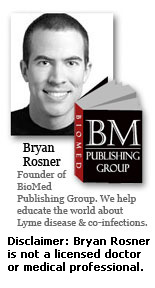News from Bryan Rosner
By Bryan Rosner on Feb 11, 2009 in General News
SPECIAL NEWS REPORT BY BRYAN ROSNER: For those readers who do not know, there is currently a controversy raging about whether or not chronic Lyme disease is a real medical condition. There is no question that acute Lyme disease is real. But heated debate enshrouds the endpoint of a Lyme disease infection. The question hinges on whether or not a standard, 10 day course of antibiotics can cure each and every case of the disease. Do lingering symptoms after treatment count as an ongoing infection, or something else – some remnant of the disease? Thousands of patients still experience symptoms after treatment. Thousands of sick people and their doctors believe in chronic Lyme disease; they have seen it, felt it, lived it. Researchers have observed it under the microscope. Hundreds of scientific studies prove the existence of chronic Lyme disease. But establishment medicine continues to deny this reality. Currently, the legal environment for Lyme-treating physicians is hostile, and physicians who prescribe long-term antibiotics for their sick patients face reprimand or even loss of their medical license.
This article will skip the long history of the debate and fast forward to the present state of affairs. To learn more about the history, we suggest reading a book like Cure Unknown or The Lyme Disease Solution.
The modern story begins with proposed Bill No. 5625, originating in the State of Connecticut. This bill would allow physicians to use long-term antibiotic treatment for Lyme disease and may set a precedent for the rest of the United States if passed. The bill represents hope after years of persecution, disciplinary action, and outright contempt for Lyme-literate medical doctors (LLMDs) by the governing medical authorities. It now looks like there may be a light at the end of the tunnel after all. Despite this hope, however, the battle is far from over.
Although the war began long ago, 2006 was when it heated up. In 2006, the Infectious Disease Society of America (IDSA) released guidelines which invalidate the existance of chronic Lyme disease as a real medical condition. Since the IDSA is considered the government authority on the matter, their guidelines, for all intents and purposes, determine what treatments physicians can and cannot use. In most of its policies, the IDSA is directly opposed to the International Lyme and Associated Diseases Society (ILADS). Among the Lyme disease community, ILADS is generally recognized as the progressive and helpful organization, while the IDSA is seen as being dogmatic and exclusionary in its stance that chronic Lyme disease is not real.
After the IDSA guidelines were heavily scrutinized, it became evident that they were significantly flawed and biased. Unfortunately, the IDSA did not agree to review their guidelines until forced to do so by an investigation conducted by the State of Connecticut Attorney General, Richard Blumenthal. Blumenthal found that the IDSA guidelines “locked out competing points of view” and ignored science pointing to the reality of chronic Lyme disease as a real condition. A state attorney general actually had to intervene in order to get a supposedly science-based organization to behave scientifically.
Although the much-needed review appeared to be a hopeful turn of events, the IDSA president continued to deny that there was anything wrong. Nevertheless, under pressure from the Connecticut Attorney General office, a review panel consisting of Lyme disease experts was created. Unfortunately, however, a recent analysis has revealed that the IDSA is appearing to, yet again, prevent an honest and scientific assessment of its guidelines. It appears that the panel of experts chosen to review the guidelines is comprised of people who have a history of biased and exclusionary policies. Absolutely no recognized LLMDs were appointed to the panel, which raises questions about the true objectivity and scientific validity of the so-called review. There is a public hearing period, taking place until April 3, 2009, during which public comments on the issue are welcome.
In the meantime, numerous physicians continue to be persecuted, disciplined, and punished for treating chronic Lyme disease, despite obvious science supporting the existence of the chronic form of the disease. I will not post links to specific legal cases in order to protect the identity of the embattled physicians.
This is a somber and trying time in history. Most of the medical review boards making front-line decisions are not even aware of the controversy, so they are making decisions – and ending physicians careers – in the dark. In one state, a proposed bill of law sits in wait. In others, authorities ignorant of that bill bring the hammer down on compassionate, life-saving physicians. Patients barely hanging on under the care of an LLMD become completely destitute after losing their doctor and the medical care that is keeping them stable. The situation continues to deteriorate.
On an encouraging note: The urgency of this tragedy has not gone unnoticed by everyone, and in fact, there is currently a one-day Lyme Legislative Seminar on the calendar, which will take place on March 28, 2009, at George Mason University, hosted by the National Capital Lyme and Tick-Borne Disease Association. You can view the agenda for the seminar here. Thankfully, there will be several people involved in the seminar who wield enough power to change the course of history, one of whom is Congressman Frank Wolf, (R-VA 10th District).
As the situation heats up, and the press corps is activated (this controversy is now being addressed on many major news networks), it will become harder and harder to protect the distorted science that currently dominates mainstream medical policy on Lyme disease. There is a light at the end of the tunnel, and the truth about chronic Lyme disease will eventually be accepted – it is inevitable. Science will win. This political armageddon will come to a close. In the words of Richard Brand, M.D.,
“We have only to keep telling the truth: That [the IDSA] makes their case by selectively employing particular studies, avoiding others which refute their position, even ignoring their own past studies and pronouncements. Their duplicity is transparent and the heat is building.” -Reprinted letter appearing in the 2008 Lyme Disease Annual Report
Psychology Today is one example of a major press outlet picking up the story. Pamela Weintraub, author of the book Cure Unknown: Inside the Lyme Epidemic, maintains a blog on Lyme disease on Psychology Today’s website. Her February 5, 2009 blog post entitled Disappearing a disease: when guidelines are biased, patients suffer makes the following observation:
“You can skew the evidence in your treatment guidelines, but you can’t stop the march of science. You can try to disappear a disease – but in the face of a burgeoning epidemic with ever more people sick, can you ultimately succeed?” –Psychology Today
I suggest that we all hope and pray that proposed Bill No. 5625 passes and that it allows chronic Lyme sufferers to exit the dark ages and begin to enjoy their long lost constitutional right to modern medical care. On the other hand, while hoping and praying are great activities, I feel that the recognition of chronic Lyme disease as a real medical condition is just as inevitable as was the acceptance of the fact that the world is not flat. In the words of Abraham Lincoln, “You can fool some of the people all of the time, and all of the people some of the time, but you can not fool all of the people all of the time.”
IN OTHER NEWS…
• 2009 Lyme-Induced Autism Conference announced. June 25-28, 2009, Radisson Fort McDowell Resort and Casino, 10438 N. Fort McDowell Road, Scottsdale/Fountain Hills, AZ 85264, 480.789.5300. SCHEDULE: Thursday, June 25 – Physicians Training and Exhibits. Friday, June 26 – Sunday, June 28th – General Session and Exhibits. Learn more about the connection between Lyme disease and autism in the new Lyme-Autism book, written by Bryan Rosner and Tami Duncan.
• 2008 ILADS Lyme disease conference video recap. The 2008 International Lyme and Associated Diseases Society scientific session was held in San Francisco, CA on October 18-19, 2008. Bryan Rosner was present at the conference and put together two summary videos. Note: These videos are unofficial and are not associated with ILADS – they are simply the personal videos from Bryan’s trip.
• Under Our Skin movie gets mega media coverage. By now most of you have heard of the groundbreaking movie, Under Our Skin, which has brought Lyme disease awareness to a whole new level. What you may not be aware of is that the publicity this movie is receiving is not limited to the Lyme disease community. The director of the movie has been interviewed on most of the major network television stations including Fox News and CNN. Watch some of the interviews here.
• New York Times: “Chronic Fatigue Syndrome no longer seen as ‘Yupee Flu'”. An article with that title appeared recently in the New York Times. Now when will the same vindication happen for Lyme disease sufferers?
• New Information on Mangosteen supplements. In The Top 10 Lyme Disease Treatments, Bryan Rosner talks about Mangosteen fruit as being one of the best supplements for Lyme disease for many reasons, including its powerful antibiotic charcteristics. However, Bryan mentions a product in the book, Xango, which he no longer believes is the best route to take. Here’s why. (Remember, Bryan is a journalist and not a medical practitioner, so this information should be treated as opinion only).
• Bryan Rosner’s book is reviewed by Katherine Duff of The Townsend Letter for Doctors and Patients. Bryan Rosner wrote The Top 10 Lyme Disease Treatments in 2007. It was recently reviewed in the October, 2008 issue of Townsend Letter for Doctors and Patients.
• Health Food Store Reward Program. Do you think your local community would benefit from Bryan Rosner’s book, The Top 10 Lyme Disease Treatments? If so, we would be willing to pay you $100 to help us place the book in your local health food store. Learn more.








